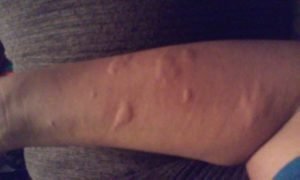Bed Bug Bites
BY : Tulsa Bed Bug Specialist
Tulsabedbugexterminator.com
Remember!
Bites are often itchy, red, and in a line.Bites usually disappear with time. Hydrocortisone creams and antihistamines may speed recovery. Bed bug bites can look very similar to bites from other insects like mosquitoes and fleas. People also have widely varying reactions to bedbug bites.The bites themselves don’t usually pose any major health risk since bedbugs are not known to spread diseases, but an allergic reaction to the bites may require medical attention, CDC officials say. Here are some pictures of what bed bug bites could look like. Contact US @ 918-892-5254 or Visit our site tulsabedbugexterminator.com
Bed bug bites have several distinguishing characteristics. Here’s what to look for:
1. Appearance
- Red, raised bumps: Often slightly swollen and inflamed.
- Clusters or lines: Bites commonly appear in groups of 3–5, sometimes called “breakfast, lunch, and dinner” pattern.
- Small central puncture: Sometimes visible in the center of the bump.
2. Location
- Commonly found on exposed skin during sleep:
- Arms
- Shoulders
- Neck
- Face
- Hands
- Legs
3. Itching and Irritation
- Intense itching is typical.
- Scratching can lead to secondary infections or scabbing.
4. Delayed Reaction
- Some people don’t react right away; it can take hours to days for symptoms to appear.
- Others may not react at all, especially with frequent exposure.
5. No Bites Under Clothing
- Bites typically occur in areas not covered by tight-fitting clothes or blankets.
6. No Blisters or Pus (Usually)
- Bed bug bites don’t typically blister or ooze unless infected. If they do, another condition might be at play.
Would you like a comparison with bites from mosquitoes or fleas to help differentiate?















Here are effective solutions for treating bug bites, including bed bug bites, to reduce itching, swelling, and the risk of infection:
🧴 Topical Treatments
- Hydrocortisone Cream (1%)
- Reduces inflammation and itching.
- Apply 1–2 times daily to affected area.
- Calamine Lotion
- Soothes itching and dries out any oozing.
- Useful for multiple or widespread bites.
- Antihistamine Creams or Gels
- Reduce allergic reactions at the bite site.
💊 Oral Medications
- Oral Antihistamines (e.g., Benadryl, Claritin, Zyrtec)
- Help with itching, especially at night.
- Good for people who react strongly to bites.
- Pain Relievers (e.g., Ibuprofen, Acetaminophen)
- Reduce pain and swelling if the bite is especially inflamed.
🧊 Home Remedies
- Cold Compress
- Apply for 10–15 minutes to reduce itching and swelling.
- Aloe Vera Gel
- Natural anti-inflammatory and soothing agent.
- Baking Soda Paste
- Mix with water to form a paste, apply for 10 minutes, then rinse off.
- Neutralizes pH and reduces itching.
- Tea Tree Oil or Witch Hazel
- Natural antiseptics that may reduce irritation (dilute before applying).
⚠️ When to See a Doctor
- Bites are very swollen, warm, or filled with pus.
- You develop fever, chills, or widespread rash.
- Signs of an allergic reaction (e.g., difficulty breathing, dizziness).
Would you like suggestions for preventing future bites too?

Recent Comments